Learning, sharing, and collaborating to build resilience together
Wisconsin’s Lake Michigan coastal communities face erosion and flooding hazards due to lake level fluctuations, coastal storms, waves, storm surges and extreme precipitation. Resilient communities plan, prepare for and adapt to these conditions so they can “bounce back” when hazardous events occur.
Many organizations, agencies, and networks in Wisconsin support coastal communities as they build resilience. These networks bring together local governments with scientists, outreach specialists, state agencies and federal partners to discuss coastal hazards, share ideas and experiences, demonstrate decision-support tools, and develop approaches to address coastal hazard issues.
This page features profiles of the various organizations and agencies that support coastal resilience in Wisconsin. Additionally, this page features a table that compares the different regional networks and projects in Wisconsin.
State Government
Wisconsin Coastal Management Program
The Wisconsin Coastal Management Program (WCMP) is preserves and improves access to the natural and historic resources of Wisconsin’s Great Lakes coasts. They orchestrate the management of ecological, economic, and aesthetic assets of the Great Lakes coastal areas. Their main program objectives include improving the implementation and coordination of regulations and policies affecting the coast, planning initiatives, assistance in coastal management, increasing public awareness, and involvement. Their grant program provides grant funding to local governments, nonprofit organizations, schools and universities, and state agencies for coastal resiliency projects. Projects that can be funded through this grant include categories such as wetland protection, pollution control, resource and community planning, education, and preservation projects.
Wisconsin Department of Natural Resources
Wisconsin Department of Natural Resources (DNR) is a state agency in charge of managing and conserving the State’s natural resources. They oversee development and administration of regulations related to wildlife, fish, forests, endangered resources, air, water, waste, and more. Within this large profile of responsibilities, the DNR has several programs that address Great Lakes coastal hazard issues like erosion and flooding for Wisconsin’s communities and residents including the Office of Great Waters, Great Lakes erosion control and permitting, coastal funding, floodplain management, and state wetland mapping programs.
Wisconsin Emergency Management
Wisconsin Emergency Management (WEM) is a division of the Wisconsin Department of Military Affairs. WEM builds capabilities and coordinates resources to support a safe and resilient Wisconsin. The bulk of WEM is organized into two Bureaus: 1) Response and Recovery; 2) Planning and Preparedness. These two sectors are responsible for carrying out the process of emergency management as well as the support for it. WEM helps communities become more resilient and able to bounce back from all manner of adverse events, including coastal hazards. They also have opportunities for communities to bounce back from hazards by offering funding for hazard mitigation assistance programs and recovery programs.
University Programs
Green Bay National Estuarine Research Reserve
The future Green Bay National Estuarine Research Reserve will be a part of the National Estuarine Research Reserve System of 30 sites across the coastal US designed to protect and study estuaries and their coastal wetlands through the integration of research, education, outreach, and stewardship. Freshwater estuaries occur in the Great Lakes where rivers meet the lake. Upon designation, the Green Bay NERR would be the third NERR within the Great Lakes and the first NERR representing the Lake Michigan-Huron biogeographic region. It will offer a coordinating force to manage, restore, and protect the Green Bay Ecosystem.
Lake Superior National Estuarine Research Reserve
The Lake Superior National Estuarine Research Reserve works to improve the understanding of Lake Superior’s coast and estuaries by addressing issues through the integration of research, education, outreach, and stewardship. The Reserve is part of the University of Wisconsin-Madison Division of Extension’s Natural Resource Institute with leadership from NOAA and membership in the National Estuarine Research Reserve System. It is based on the University of Wisconsin-Superior campus in the City of Superiors and encompasses over 16,000 acres along the St. Louis River freshwater estuary in Wisconsin.
University of Wisconsin Sea Grant Institute
Sea Grant is a federal-university partnership between the National Oceanic and Atmospheric Administration (NOAA) and university-based programs in each U.S. coastal state as well as Puerto Rico and Guam. The Sea Grant network is highly interdisciplinary, consisting of 3,000 scientists, engineers, public outreach experts, educators, and students to help citizens better understand, conserve, and protect coastal resources. Sea Grant is specifically interested in promoting healthy coastal ecosystems, sustainable fisheries and aquaculture, resilient coastal economies, and environmental literacy and workforce management.
Wisconsin State Cartographer’s Office
The State Cartographer’s Office is a part of the Department of Geography at the University of Wisconsin-Madison. It provides maps, cartography, geographic information systems, land information system, land information systems, geospatial technology, and educational workshops to geospatial data producers and consumers in Wisconsin. SCO also serves as a liaison between government, education, non-profit and private sectors to help with projects and expand the use of geospatial technology.
Regional Planning Commissions
Bay-Lake Regional Planning Commission
The Bay-Lake Regional Planning Commission provides planning and technical services through various federal, state, and local programs to their member local governments in northeast Wisconsin. They partner with state and federal governments to help these local governments create and execute successful community projects. The Commission works with Brown, Door, Florence, Kewaunee, Manitowoc, Oconto, and Sheboygan County. The region has over 400 miles of coastal shoreline along Lake Michigan and Green Bay and contains 12 major watershed areas that drain into Green Bay and Lake Michigan.
Southeastern Wisconsin Regional Planning Commission
The Southeastern Wisconsin Regional Planning Commission provides essential information and planning services to help solve technical problems and focus regional attention on key issues of regional consequences. Their regional approach is necessary for properly planning and designing public work systems and addressing environmental issues, such as coastal resilience. SEWRPC serves seven counties in southeastern Wisconsin: Kenosha, Milwaukee, Ozaukee, Racine, Walworth, Washington, and Waukesha.
Non-Profit Organizations
Great Lakes and St. Lawrence Cities Initiative
The Great Lakes and St. Lawrence is a binational coalition of over 200 municipal and regional U.S. and Canadian mayors and local officials working to advance the protection and restoration of the Great Lakes and St. Lawrence River. Member cities work together with other orders of government and stakeholders to improve infrastructures, programs, and services and increase investments in protection and restoration work. Overall, the hope is to get mayors engaged and inform the public, collaborate with all orders of government, and work with other sectors to advocate for stewardship of the Great Lakes and St. Lawrence River.
Lakeshore Natural Resource Partnership
The Lakeshore Natural Resource Partnership fosters partnerships, cultivates projects, promotes discussions, and advocates for the conservation and protection of the Great Lakes basin. They help develop new programs and supports existing community-based efforts by providing program and project funding, administrative services, and bridge-building between partners. Their focus area is the communities of northeast and east central Wisconsin within Lake Michigan’s watershed from Green Bay to Washington Island and down to Sheboygan.
The Nature Conservancy
TNC in Wisconsin supports the development of more resilient coastal communities by protecting and restoring coastal habitat and providing science based solutions as a collaborative partner on coastal projects. A strategic priority in Wisconsin is working to incorporate diversity, equity, inclusion and environmental justice to preserve outdoor spaces for all.
Wisconsin Wetlands Association
The Wisconsin Wetlands Association is a non-partisan, science-based professional organization that is a leader in Wisconsin wetlands work. WWA is dedicated to the protection, restoration, and enjoyment of wetlands and associated ecosystems through programming, education, and advocacy. In addition, the organization prioritizes providing tools and expertise to help others protect, manage, and restore wetlands.
Federal Government
U.S. Army Corps of Engineers
The United States Army Corps of Engineers (USACE) is a federal agency with a guiding mission to “deliver enduring engineering and water resource solutions to the nation, in collaboration with partners, to protect the environment, energize the economy, and strengthen our national security”. The U.S. Army Corps of Engineers is made up of biologists, architects, project managers, and many types of engineers to support engineering solutions to reduce disaster risk and support economic development.
Other Organizations & Agencies
Networks
Coastal Resilience Community Impact Project
Overview
The Coastal Resilience Community Impact Project assists municipal and county staff in communities along the western coast of Lake Michigan to develop adaptation and resilience strategies to respond to flooding, erosion, and related climate change driven hazards.
Goal
Support coastal communities’ response to the impacts of climate change and resulting lake level changes.
Focus Area
 Western coast of Lake Michigan:
Western coast of Lake Michigan:
- Port Washington
- Sheboygan
- Manitowoc
- Two Rivers
- Kewaunee
- Algoma
Project Components
- Workshops: Training workshops that focused on (1) the challenges of precipitation changes on communities; (2) steps to resilience planning; and (3) practical tools for resilience implementation such as green infrastructure, innovative technologies and financing, and municipal code and water stewardship audits.
- Community Meetings: One-on-one meetings to assess overall needs, share resources, prioritize projects, help to design and implement resilience planning frameworks, and align projects with potential funding.
- Prioritized Project Lists: Working with communities to develop a list of prioritized projects, identify funding opportunities, and draft grant applications.
Coordinating Organizations
- Lakeshore Natural Resource Partnership
- Water365
Visit the Coastal Resilience Community Impact Project Website
Coastal Hazards of Superior
Overview
Coastal Hazards of Superior (CHAOS) is a community of practice for Minnesota and Wisconsin’s Lake Superior coastlines. CHAOS is a platform for engaging local community leaders, managers, researchers, and communicators with a shared concern about coastal hazards and their impacts.
Goal
CHAOS aims to help build strong collaborations between those impacted by coastal hazards and those with resources to study, address, or mitigate impacts.
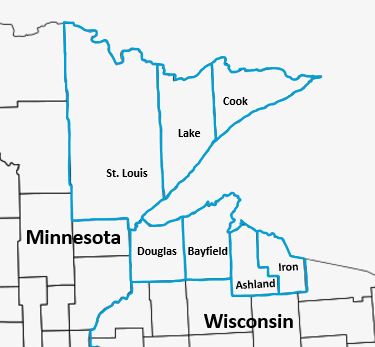 Focus Area
Focus Area
The main focus area of CHAOS is Western Lake Superior; however, the community of practice is open to all Lake Superior communities and strives to have representation from across the region, across disciplines, and all levels of government.
Minnesota & Wisconsin Western Lake Superior Coastal Counties:
Minnesota: St. Louis County, Lake County, and Cook County
Wisconsin: Douglas County, Bayfield County, Ashland County, and Iron County
Project Components
- Community of Practice: Meetings and field trips help keep the community informed and facilitate regular updates on efforts to protect the coasts of western Lake Superior.
- Monthly Newsletter: Regular communications to local communities, decision-makers, and private citizens about resilience tools and resources, training opportunities, funding opportunities, events, and more.
Coordinating Organizations
- Lake Superior National Estuarine Research Reserve
- Minnesota Lake Superior Coastal Management Program
- Minnesota Sea Grant
- National Oceanic and Atmospheric Administration
- Wisconsin Sea Grant
- Wisconsin Coastal Management Program
East River Collaborative
Overview
The East River Collaborative (ERC) is a community-driven approach to flood resilience planning in the East River Watershed, which is primarily in Brown County, Wisconsin.
Goal
The ERC brings local governments together with the goal of collectively achieving a common version of a more resilient, flood-prepared East River Watershed.
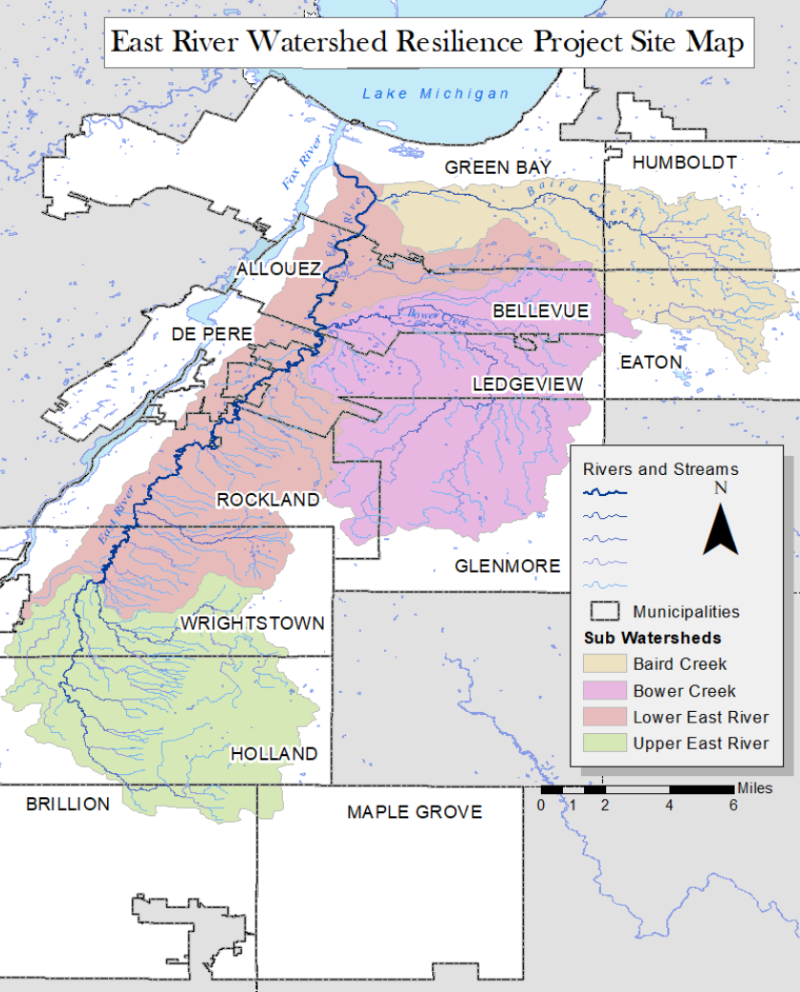 Focus Area
Focus Area
East River Watershed
- City of Green Bay
- Town of Humboldt
- Town of Eaton
- Village of Bellevue
- Town of Ledgeview
- Village of Allouez
- City of De Pere
- Town of Glenmore
- Town of Rockland
- Village of Wrightstown
- Town of Holland
- Town of Maple Grove
- City of Brillion
- Brown County
Project Components
Community of Practice: Meetings and field trips help share flooding perspectives across the watershed and bring flooding expertise to stakeholders.
Flood Resilience Assessment: A framework to better understand the impacts of flood hazards in a community and identify opportunities to increase flood resilience.
Flood Scenario Modeling: New flood modeling analysis of extreme rainfall and Lake Michigan water level scenarios to guide the development of strategies to address flooding.
Coordinating Organizations
- NEW Water
- Wisconsin Sea Grant
- The Nature Conservancy
- UW-Madison Department of Civil and Environmental Engineering
Lake Michigan Coastal Resilience Initiative
Overview
The Lake Michigan Coastal Resilience Initiative aims to build capacity among Great Lakes municipalities to strengthen and respond to coastal zone challenges such as coastal erosion, flooding, and storm events. The Lake Michigan Coastal Resilience Initiative is a 2-phase project that provides support to Lake Michigan municipal leaders and natural resource managers. The Initiative ultimately develops engineering and design plans for site-specific, locally-driven, nature-based shoreline projects. This project will be expanded to other basins in the future.
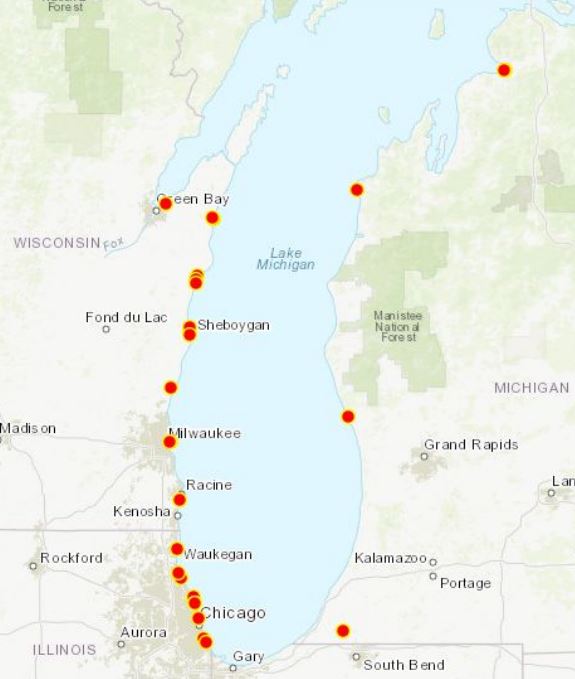
Goal
To support the development of competitive, municipal-scale projects that incorporate the development of nature-based solutions in coastal areas and to support the habitat and species goals of the Great Lakes Restoration Initiative (GLRI).
Focus Area
Lake Michigan municipalities in:
- Wisconsin
- Illinois
- Michigan
Project Components
- Phase 1 – Trainings & Workshops: Webinars to educate local officials on resources, tools, best practices, and engineering options for implementing nature-based infrastructure in coastal areas.
- Phase 2 – Municipal-Scale Projects: One-on-one technical assistance to refine municipal-scale project proposals aimed at addressing coastal resilience. Engineering and design plans to create “construction ready” projects are developed for selected proposals.
Coordinating Organizations
- Great Lakes and St. Lawrence Cities Initiative
- National Oceanic & Atmospheric Administration
Visit the Lake Michigan Coastal Resilience Initiative Webpage
Northeastern Wisconsin Coastal Resiliency Study
Overview
The Northeastern Wisconsin Coastal Resiliency Study works with coastal communities in Northeastern Wisconsin to examine their coastal hazards issues and identify opportunities to build resilience strategies into local planning efforts.
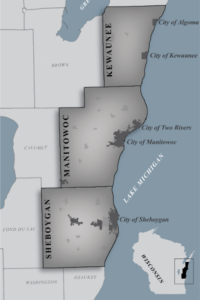
Goal
To advance the region’s ability to adapt to and withstand coastal threats.
Focus Area
Coastal communities in:
- Sheboygan County
- Manitowoc County
- Kewaunee County
Project Components
- Achieving a Resilient Coast: A report summarizing Northeastern Wisconsin coastal hazard issues and needs, with a framework to help plan for resilience.
- Resiliency Portal: Information hub with educational resources, maps, data, funding opportunities, and a virtual field trip of the region’s coastal hazard issues.
Coordinating Organizations
- Bay-Lake Regional Planning Commission
- Wisconsin Sea Grant
Visit the Northeast Wisconsin Coastal Resiliency Study Website
Wisconsin Initiative on Climate Change Impacts
Overview
The Wisconsin Initiative on Climate Change Impacts (WICCI) is a statewide collaboration of scientists and stakeholders formed as a partnership between UW-Madison’s Nelson Institute for Environmental Studies and the Wisconsin Department of Natural Resources. The mission of WICCI is to generate and share information that can foster solutions to climate change in Wisconsin.
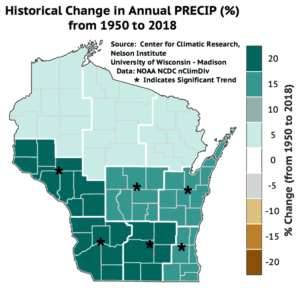
Goal
WICCI engages citizens, private and public decision-makers, and scientists from Wisconsin and the region in a collaborative network to (1) develop scientific understanding of climate impacts, (2) identify vulnerability to climate change and climatic variability, and (3) enable better adaptation activities.
Focus Area
State of Wisconsin
Project Components
- Climate Assessment Report: Explains the issues and impacts of our warming climate on Wisconsin residents and describes the scientific progress made toward solutions.
- Working Groups: A number of WICCI Working Groups explore how changing climate conditions will impact Wisconsin’s Great Lakes resources and potential solutions to these issues. These include the Coastal Resilience Working Group, Great Lakes Working Group, and the Infrastructure Working Group.
Coordinating Organizations
- Wisconsin Department of Natural Resources
- University of Wisconsin-Madison’s Nelson Institute for Environmental Studies
Wisconsin Coastal-Management Data Infrastructure Project
Overview
The Wisconsin Coastal-Management Data Infrastructure (WICDI) provides data, tools, and training to address regional coastal hazard mapping issues. WICDI has used culvert data to implement their cloud-based data infrastructure. At-risk culverts can be identified through inventorying and mapping which can help justify the need to upgrade or replace vulnerable infrastructure.
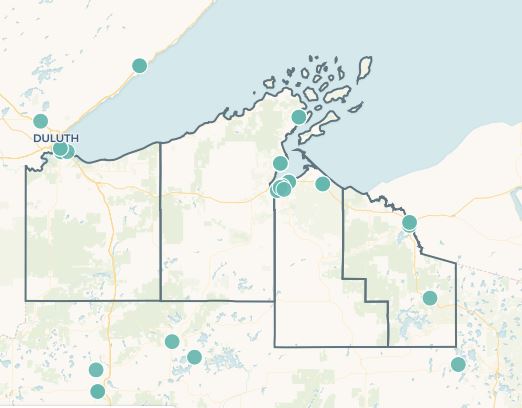
Goal
Provide the resources needed for coastal and culvert managers to quickly and appropriately respond to damages or identify vulnerable culverts before catastrophe and to increase flood resilience.
Focus Area
This project originally focused on Wisconsin’s Lake Superior coastal communities, but is currently expanding to include Wisconsin’s Lake Michigan coastal communities as well.
Project Components
- Community of Practice: Shared, cloud-based data infrastructure supports the work of the interdisciplinary community of practice. Land and water conservation departments, road and highway departments as well as those working on fish passage, storm water management, flooding, and water quality modeling need this information to make their models reflect the real world.
- Lake Superior Culvert Inventory Database: The culvert inventory database serves as an index of where road and stream crossings are present, who has inventoried the culverts and when, and what attributes they have collected. Anyone can use the database for mapping streams, lakes, and wetlands.
Coordinating Organizations
- Wisconsin Coastal Management Program
- Wisconsin Department of Administration
- Wisconsin State Cartographer’s Office




